Terrestrial and Restoration Ecology
Matt Orr, Ph.D.
Animal Probiotics
Pat Ball, Ph.D. and Bruce Seal, Ph.D.
Fungal Genetics and Plant Conservation
Kristina Smith, Ph.D.
Macroecology and Evolution
Brian Tanis, Ph.D.
Terrestrial and Restoration Ecology
Matthew Orr
Associate Professor, Biology
Ph.D. in Population Biology

Dr. Orr's students examine questions in terrestrial and restoration ecology in forest, field, and stream habitats in Central Oregon. He has also begun to apply principles of restoration ecology to the gut microbiome. His research has been published in Nature, Ecology, Evolution, Animal Behavior, the Quarterly Review of Biology, and Zygon: Journal of Religion and Science, and can be viewed on Research Gate and Google Scholar (curriculum vitae).
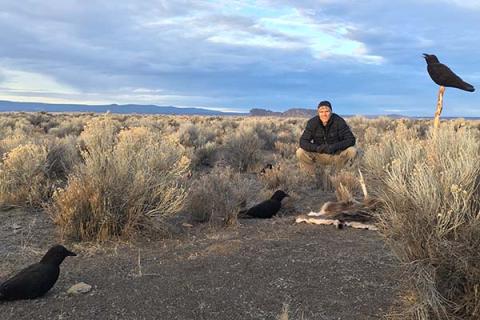
Testing for behavioral relationships between scavenging corvids and raptors using a synthetic carcass (deer hide) and raven decoys (Orr et al. 2019 Animal Behaviour 153: 105-113).

Building beaver dam analogs on the South Fork of the Crooked River with Bi 375, Field Methods in Ecological Restoration (Orr et al. 2019 Northwest Science 93: 171-184). Watch video

Dr. Orr constructed this field camp with help from Trout Unlimited. His summer field course (Bi 375: Field Methods in Ecological Restoration) stays here to study restoration of standing dead wood by bark beetle pheromones, tree topping, and girdling, and subsequent use by cavity-nesters.
Animal Probiotics
Patrick Ball
Program Coordinator and Senior Instructor II, Biology
Ph.D. in Microbiology and Biochemistry

Bruce Seal
Instructor, Biology
Ph.D. in Biochemistry

Dr. Ball and Dr. Seal lead a team of students working on Animal Probiotics Discovery. Live microbial cultures or probiotics have been utilized to improve the health of animals, including humans. However, new approaches are needed to develop the "next-generation" of novel therapeutic microbials for the treatment of diseases such as inflammatory bowel disease in dogs, and to improve overall animal health.
Their strategy is to find beneficial bacteria in the wolf GI-tract material and feces. They hypothesize that the discovery of probiotic bacteria from free-ranging animals such as the wolf can be marketed for domestic animals, especially pets such as domestic dogs, to replace their evolutionary-based microbiota and improve their health.
Specific research first involves isolating novel bacterial species from wolf gastrointestinal material obtained from the Oregon Veterinary Diagnostics Laboratory, OSU College of Veterinary Medicine. This entails basic microbiological approaches to obtain individual bacterial colonies followed by basic phenotypic analyses. Finally, bacterial genomics information will be required that begins with 16S rRNA gene sequencing to classify isolates. Subsequently, full-genome sequencing of the bacterial isolates will be required to identify those genes correlated to probiotic activities such as butyrate production. The plan is to enlist an industry partner in a business-to-business approach to assay potential probiotic bacteria efficacy to meet the regulatory and quality requirements of a final product formulation.

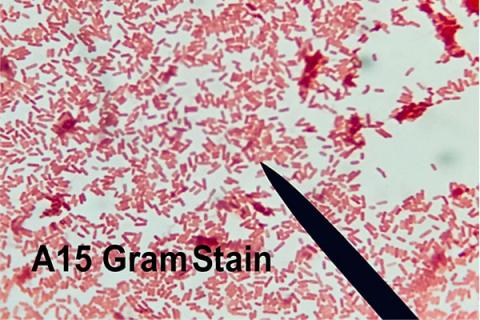
Two aerobic bacterial isolates were characterized as Gram positive bacilli, and identified as novel Spororsarcina species.
Fungal Genetics and Plant Conservation
Kristina Smith
Senior Instructor, Biochemistry and Biophysics
Ph.D. Biological Sciences

Laboratory Research
Students use fungal model organisms like Neurospora crassa to study the function of essential genes. Since these genes cannot be disrupted without killing the organism, researchers take advantage of a natural mutagenesis system, Repeat Induced Point (RIP) mutation, to introduce random C to T transition mutations in genes of interest. Through this experience, students learn standard microbiology and molecular biology techniques.
Summer Field Research
For students interested in conservation biology, Dr. Smith collaborates with botanists in the U.S. Forest Service to study an endemic high desert plant. Pumice grape fern (Botrychium pumicola) populations scattered throughout Central Oregon are declining. U.S. Forest Service scientists are trying to understand why this endemic plant is disappearing, and help conserve and restore it. This project involves population sampling during early summer and collection of other data for ecological modeling.

Wild-type Neurospora phenotype (left) compared to a slow growing developmentally delayed cdc-4 mutant (right).
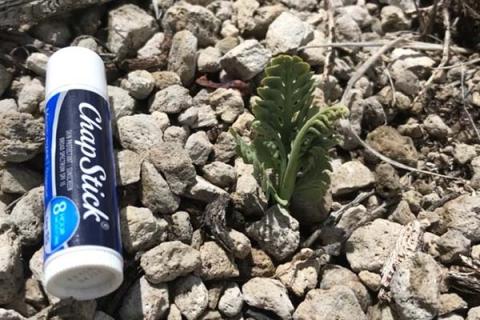
Pumice grape fern emerges in early summer in pumice fields east of Bend and on high mountain peaks.
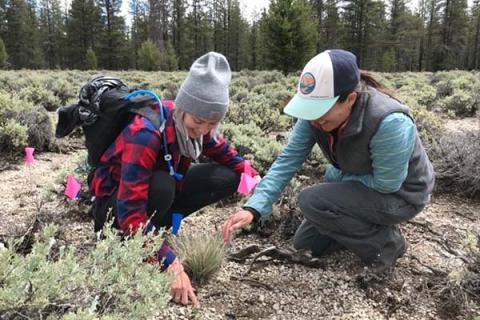
Students assist USFS botanists with flagging and counting plants.
Macroecology and Evolution
Brian Tanis
Instructor, Biology
Ph.D. Zoology

Dr. Tanis' research focuses on understanding the dynamic processes which drive interactions within and between mammalian species, shape large-scale ecological and evolutionary patterns across space and time, and the degree to which these patterns and processes have been altered by anthropogenic activities. Specifically, he leverages morphological features and physiological processes of modern, historical and paleontological specimens to study changes in niche breadth and species interactions across small to large temporal and spatial scales. Dr. Tanis' work is interdisciplinary, integrating across the fields of ecology, evolution, physiology, biogeography and paleobiology, and informs on fundamental questions of ecosystem functions while also providing and testing applied hypotheses for conservation managers.
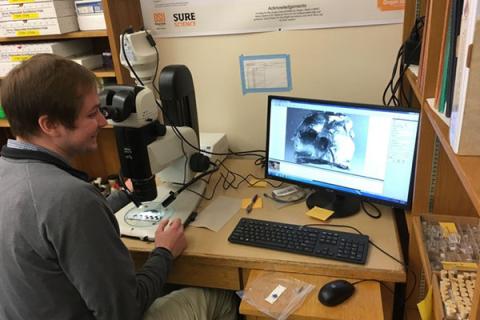
Imaging the skulls and teeth of small mammals via a confocal dissecting microscope to measure variation in morphological features.

The lower jaw from Cormocyon copei, an extinct species of the “bone-crushing” canids. This 23-million-year-old fossil came from the John Day Formation in central Oregon.

Dental impression molds being taken of molars on jaws of wolves. These molds are used to reconstruct historical diets and better understand interactions between wolves and coyotes before regional extirpations.